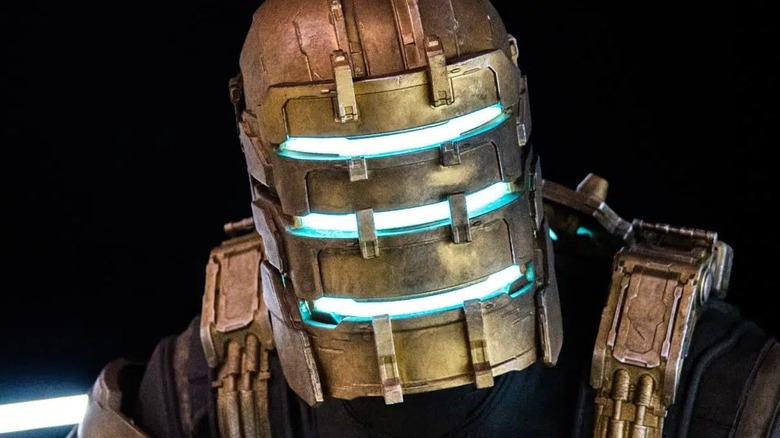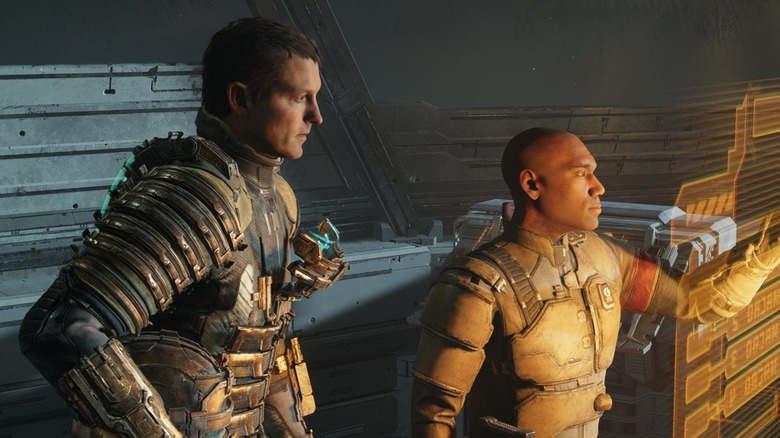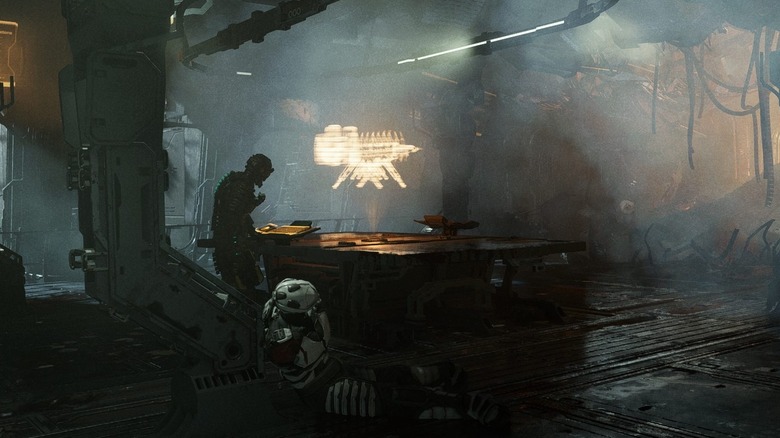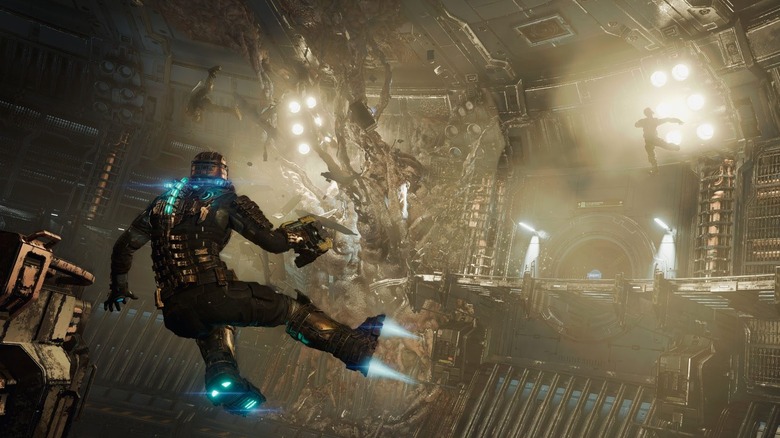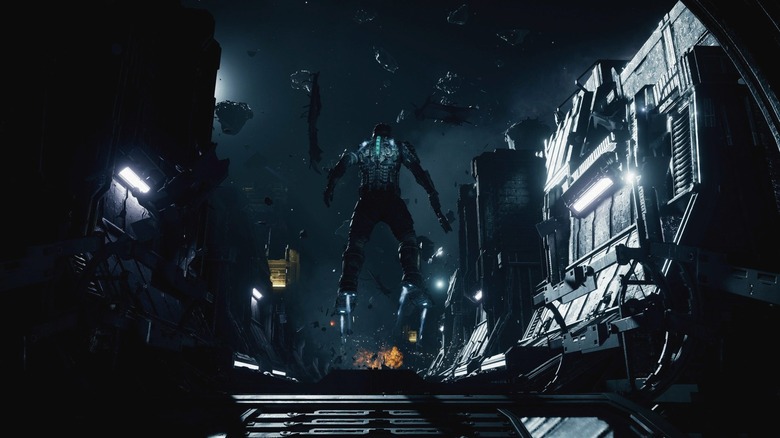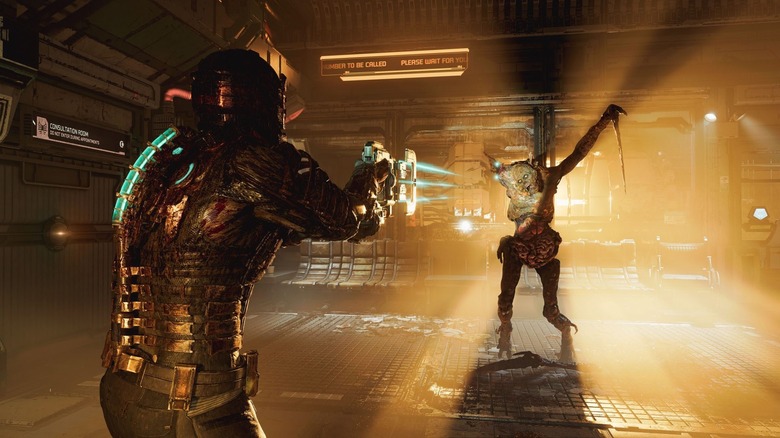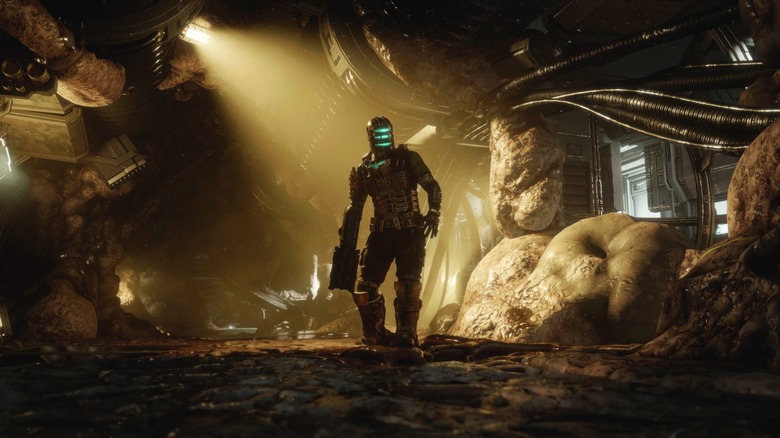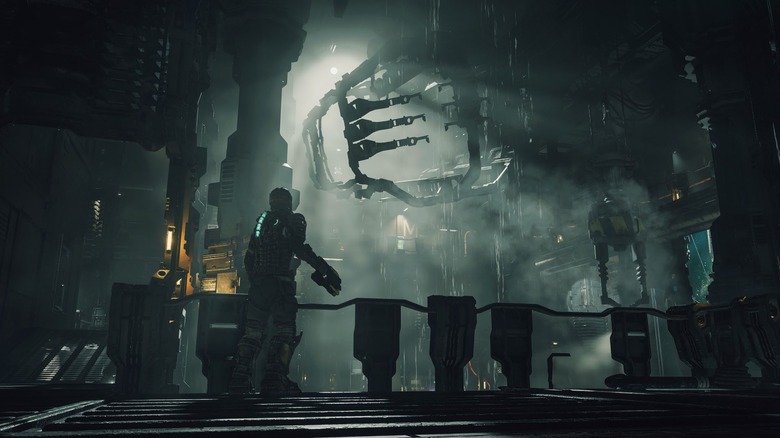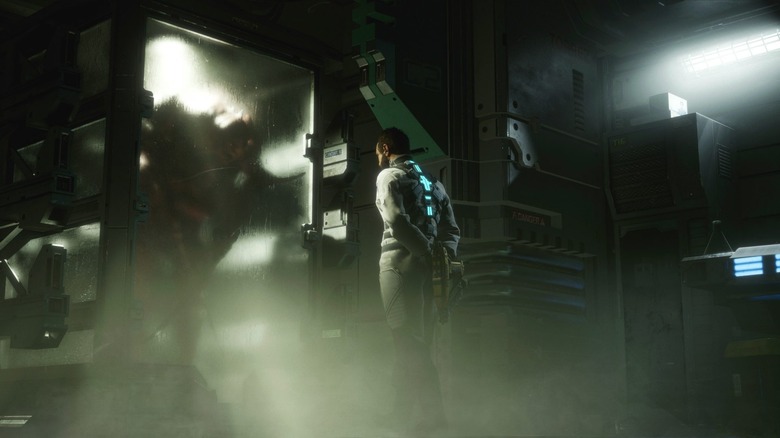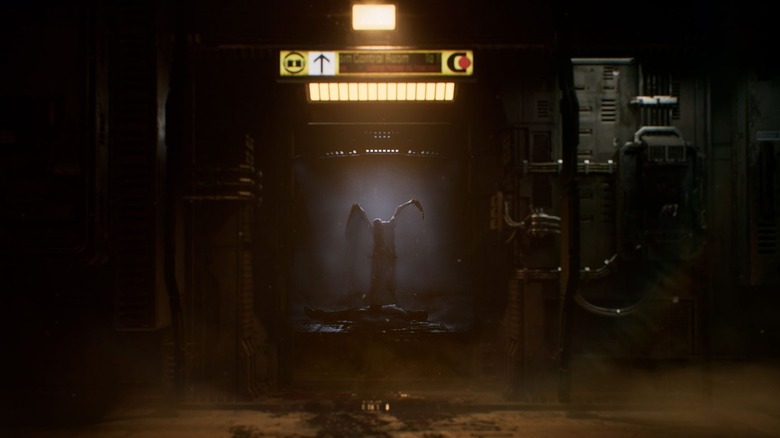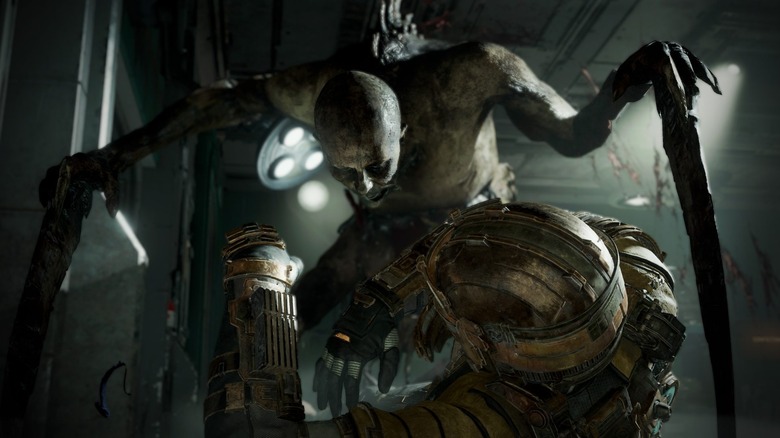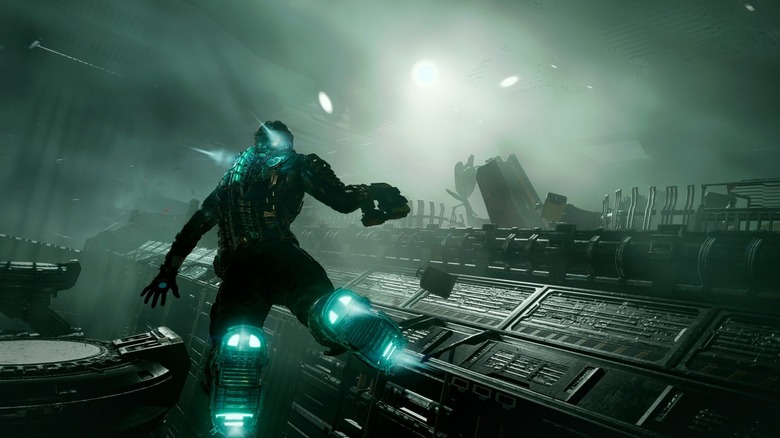What The Dead Space Remake Does Better Than The Original
The original "Dead Space," released in 2008, catapulted the survival-horror genre to new heights. Dismembering nightmare-inducing Necromorphs throughout the bloodied remains of the USG Ishimura as the voiceless Isaac Clarke was unforgettable. Reviewers like IGN, in 2008, affirmed that "Dead Space" did the genre proud. Time was likewise friendly to the memory of "Dead Space," with publications like Gaming Digest claiming that it was still, "one of the best horror games ever made," in 2021.
In that same year, 2021, EA announced that "Dead Space" would be remade for modern gaming systems under the developmental lead of EA Motive.
The "Dead Space" remake houses obvious improvements like graphics, lighting, and sound design. However, "Dead Space" pushes beyond a simple update by expanding on its story and mechanics. And, it turns out, both players and critics have absolutely loved this remake. So, what exactly did change between the original "Dead Space" and its 2023 remake that has everybody raving?
Isaac finally has a voice
One of the original game's most memorable quirks is Isaac Clarke's complete lack of a voice. In a wide cast of well-voiced and well-written characters, the game's primary vehicle for the player remains mute for the whole enthralling adventure. Later in the franchise, starting with "Dead Space 2," Isaac was voiced by Gunner Wright, the voice actor who has stuck with the role ever since.
Isaac's lack of a voice in the original "Dead Space" corresponds to a slight lack of characterization for the game's protagonist. A core tenant of the development of "Dead Space" was total immersion — all parts of the UI are on-screen, no fast-traveling, etc (per IGN). This immersion-first approach worked well, but Isaac's lack of a voice stuck out like a sore thumb.
Therefore, perhaps the most glaring difference between the two games is how playing Isaac Clarke feels. The original game made Isaac feel robotic, like he was just a vessel for taking orders and carrying the player around. The remake, however, gives more life to Isaac's qualities of leadership, determination, selflessness, fear, and regret through Gunner Wright's performance of the remade script. All in all, Isaac is a far more layered and sympathetic character in the remake due to his character adding to the immersion rather than subtracting from it.
Reworked Story Elements
The original "Dead Space" does deserve all the props it gets, but some of its story elements deserved reworking after all these years. In particular, the game's characterization could be more fleshed out, and that is basically what the EA Motive's team ended up achieving with their remake (per EA).
For instance, in the 2008 "Dead Space," Hammond is the order-delivery leader who lacks an empathetic side. And in the remake, Hammond retains his authoritarian nature but his character and his actions are more grounded in trauma, giving players more empathy towards him.
Another example of improved story mapping for the game's characters is how Chen and Johnson are treated. They are the characters that die in the opening scene of "Dead Space," in that iconic shot of a Necromorph ripping apart a person through a glass wall. And that's basically all they do in the original — get torn to shreds. However, the remake upped the ante of their sacrifice by having Chen turned into a Necromorph that ends up hunting down Hammond and trapping him into an escape pod. Johnson, similarly, gets more screen time and becomes an even sadder sacrificial character after Hammond's selfish orders in the remake eventually get her killed. Throughout the rest of the game, characters make references to both Chen and Johnson which also adds to the layered humanization that the remake provides the story.
Cleaned Up Gameplay
For all the genius of "Dead Space's" gameplay mechanics, like its unforgettable dismemberment system, the original game had some rather clunky elements that have aged poorly. In particular, the Zero-Gravity experiences in the original game had notoriously clunky controls and a general lack of purpose and immersion that frustrated many players. The team at EA Motive recognized this and improved the Zero-G gameplay components massively by fine tuning its controls with propulsion boosters while also giving the player more agency to use and explore the Zero-G areas (per EA).
Another clunky element of the original "Dead Space" was its underutilization of the oxygen mechanic. The vacuum space areas where oxygen was depleted from Isaac's suit were few and far between, and recharging Isaac's suit with oxygen proved to not be a challenge. The remake, however, introduces Circuit Breakers into the game, which force players to choose whether they want to supply light or oxygen to rooms they are entering. Thus, upgrades to Isaac's suit regarding its oxygen capacity are no longer relatively useless due to the circuit breakers.
Lastly, the "Dead Space" remake upgraded weaponry by expanding their upgrade paths. There really wasn't a lack of diverse weaponry in the game, but having even more fun options certainly does not hurt. Overall, the raw mechanical gameplay of the "Dead Space" remake greatly improved.
Updated Graphics and SFX
The horror genre relies heavily upon immersion and atmosphere in order for its intended effect to work. An atmosphere will only feel scary if certain moods are created, and "Dead Space" is an absolute masterpiece at generating fear.
EA Motive was cognizant of these core affectual experiences and it wanted to amplify those feelings of isolation, survival, and grotesque horror that permeate the USG Ishimura (per EA). The first place to start with such amplifications in the remake was the game's newfound graphical capacity. The original "Dead Space" released in 2008 for the Playstation 3 and Xbox 360 generation of consoles, so updating the game's audio and visuals was certainly due.
In a dev blog post, Senior Game Director Eric Baptizat explained that, "There are a lot of enhancements in terms of visuals, audio, lighting — everything is more dynamic." Particularly, the game's dynamic lighting system was improved, and this comparison video does a good job showcasing how much is changed between the two versions of the game. However, the lighting changes may have been too drastic for some users, because upon the remake's launch some players reported muted graphics in the dark as a consequence of VRS (variable rate shading) that needed a patch from the developers allowing it to be turned off (per GameSpot). Despite that small hiccup, though, the "Dead Space" remake looks and feels every bit of a 2023 game.
Dismemberment is even better
Necromorphs in the original "Dead Space" game are some of the most horrifying video game monsters to ever grace the screen. Their fast, unrelenting, and viscous nature is well-established at the very start of the game with Chen and Johnson's deaths, as well as with this memorable elevator escape scene. And taking out these iconic baddies was done with perhaps the most innovative mechanic of "Dead Space:" dismemberment.
The first weapon that Isaac receives is the Plasma Cutter, and it remains a trusty weapon throughout the entire game because it is designed around the dismemberment system. The uber-fast and bounding physique of Necromorphs needed countering somehow, and shooting off their limbs turned out to be the solution. Once a Necromorph was relieved of its limbs at the joints it becomes much less threatening to the point where the player can comfortably choose their method of execution.
The "Dead Space" remake takes this amazing system and improves upon it further by adding a "peeling system," a fancy term for saying that each Necromorph now has multiple layers of flesh and bone required for dismemberment. So, instead of giving Necromorphs a conventional HP bar, the peeling system is intended to give players a dynamic reading of how much damage they are doing based on how much they have "peeled" the Necromorph. Therefore, the impressive visuals of dismemberment are married with gameplay mechanics and decision-making like never before.
New Impossible Mode
After beating the original "Dead Space" on any difficulty level, a new challenge, Impossible Mode, is opened up for the player. Similar to the balance changes made in the hard difficulty setting, Impossible Mode makes Necromorphs deal more damage while taking less themselves while also vastly reducing the amount of available resources to the player, like credits and ammo.
Instead of following suit, the remake changes many aspects of Impossible Mode. First of all, playing Impossible Mode is made available from the very start of the game for the player as opposed to only after the game has been completed. This is because Impossible Mode in the "Dead Space" remake acts an Ironman Campaign — there is only 1 save slot available and players are not allowed to die. That's right, the entire Impossible Mode run is over if the player dies. If the player wants to not lose the progress of that campaign then they can return to the last save point but only on a lowered difficulty. This makes Impossible Mode a sort of roguelike game where only the most experienced and skillful players will be able to complete an entire playthrough of "Dead Space" without blemishes.
Completing the herculean feat of the "Dead Space" remake on Impossible Mode is recognized by the developers by giving players the best gun in the franchise — the Hand Cannon, a red-foam finger that one-shots most enemies and has Isaac hilariously say "Pew" when he shoots it.
A New Player-Friendly Ship
A major consideration for the team at EA Motive with the "Dead Space" remake was how to reimagine the USG Ishimura. In a dev blog, associate Art Direction Roy Tuazon said that, "The Ishimura is an iconic ship because it was treat like a main character ... [The original team] did an amazing job keeping the player immersed in the ship, and left us wanting to see more." This same love and attention certainly went into the remake because the USG Ishimura is more immersive than ever.
Basic improvements like upsizing or downsizing corridors, or connecting previously unconnected hallways, makes navigating the remade USG Ishimura a more intuitive task, as opposed to the labyrinthine feel of the original game (per EA). Roy Tuazon further explained that, "We didn't just add things to add them. Everything we did, we did because it made sense, because it fit."
Other great fits to games immersion within the USG Ishimura is the complete removal of loading screens. This required some high-end engine capabilities from Frostbite in order to stream-in dynamic data that changes the ship according to the player's progression without loading screens. And another welcome change is the 3D maps of the original game being turned into more readable 2D maps (per Inverse). All in all, "Dead Space's" immersion, one of its most important qualities, is greatly improved by these additions.
Brand New Side Missions
Expansive RPGs almost always have side missions for a variety of reasons — they are great lore delivery vehicles, they change up the pace of play and can introduce novel gameplay mechanics, and they make the game-world feel more lived-in. The original "Dead Space" is no stranger in this regard, and furthermore, the "Dead Space" remake adds on 3 additional side missions.
Scientific Methods is the earliest new side mission available to players in 2nd chapter. It follows Isaac's exploration of Dr. Nicole Brennan's experiences with Dr. Mercer and players who complete it earn the "Whole Again" achievement. You Are Not Authorized sets Isaac out in quest for all 7 obtainable RIGs from different locations throughout the game. Once obtained, players who complete this side mission gain access to everywhere in the USG Ishimura and are rewarded with the "Full Clearance" achievement. Premeditated Malpractice has Isaac investigate the frozen piece of tissue sample that is obtained at the end of Chapter 5. This shorter side mission ends with the "Final Regeneration" achievement.
Alternate Ending
The main campaign of "Dead Space" reportedly takes around 10 hours to complete, and the entire game takes around 15-20 hours to complete. While that is not the longest RPG, it still isn't a game with a quick playthrough — especially for players experiencing the game for the first time.
Almost all the same main story elements are used in the "Dead Space" remake, including the ending, but the remake adds in an additional alternate ending that is only obtainable on a New Game Plus playthrough. New Game Plus is a mode where players restart the campaign after completing it while retaining their credits, gear, and all their upgrades.
The game's difficulty is raised in New Game Plus and 12 exclusive collectible items are also added. Collecting those 12 Marker Fragments is what ultimately unlocks the alternate ending in the "Dead Space" remake. Therefore, only players who have beaten the game twice are capable of earning the alternate ending which hints at a "Dead Space 2" remake (per SVG).
A Personalized Intensity Director
The "Dead Space" remake improves on many aspects of the original game while at the same time adding in completely new game systems. One of the most impactful new game systems added to the remake is the custom "Intensity Director" that now regulates dynamic and randomized encounters.
Specifically, the Intensity Director is, "a content organization, spawning, and pacing control system," according to Senior Systems Designer Dan Kim, "And depending on how we count things, the system has more than 1200 unique events" (per EA). These events are constituted as audio and lighting changes with fog and steam as well as differentiated enemy spawns.
That means that one playthrough of "Dead Space" will never be exactly the same as another, and the benefits of that in a horror-survival game is hard to understate. A major lynchpin of the horror genre's success is viewer expectations, and constantly playing on and inverting those expectations makes good horror. After all, if someone has played "Dead Space" enough to know exactly where everything is, then the jump-scares don't work anymore. But, with the Intensity Director in play, players must always be on their toes for new experiences.
Player-Moderated Gore Settings
Without a doubt, "Dead Space" is an intense game. Its core monster, Necromorphs, are mutated humans with nightmarish appearances that are often best dealt with through dismemberment. Thus, "Dead Space" is put into that category of "hard to convince a parent to buy it" for younger people.
The body horror, gore, and visceral dismemberment system that makes "Dead Space" such an iconic piece of the survival horror genre can be off-putting to enjoyers of less gruesome horror. As a result, the "Dead Space" remake offers two new settings for players who do not wish to experience the over-the-top gore of the game (via PC Gamer).
First, developers added a setting that enables content warnings before particularly gruesome cutscenes and events. And second, the game now includes a setting that blurs the whole screen during those intense moments. Escaping the brutality of "Dead Space" is challenging because the entire game is coated in violence, but these additional options will hopefully go a long way improving the accessibility of the "Dead Space" experience.

